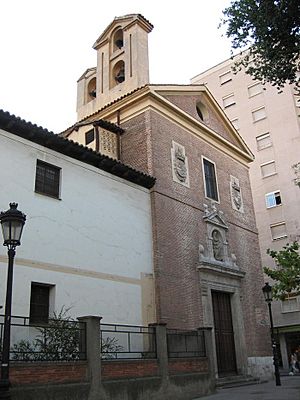Convento de Las Descalzas Reales, Valladolid facts for kids
Quick facts for kids Monasterio de las Descalzas Reales |
|
|---|---|
 |
|
| 41°39′21″N 4°43′16″W / 41.65583°N 4.72111°W | |
| Location | Valladolid, Castile and León, Spain |
| Denomination | Roman Catholic |
| History | |
| Founded | 1550 |
| Architecture | |
| Heritage designation | National Monument |
| Designated | 1974 |
| Architect(s) | Francisco de Mora |
| Architectural type | Classical Baroque |
| Administration | |
| Diocese | Valladolid |
The Monasterio de las Descalzas Reales is a historic monastery in Valladolid, Spain. Its name means "Monastery of the Barefoot Royals." This is because the nuns who live there, from a group called the Colettine Poor Clares, choose to go barefoot inside their living areas. It's important not to confuse this monastery with another one in Madrid that has a similar name.
The monastery was first started in Villalcázar de Sirga in 1550. It was dedicated to Our Lady of Pity. In 1552, the community of nuns moved to their permanent home in Valladolid. King Philip III of Spain ordered the monastery's dedication to be changed to Our Lady of the Assumption. He also began a project to rebuild parts of the monastery.
The monastery is located in a large area of the city. It sits between Ramón y Cajal street and the corner of San Martín and Prado streets. The building you see today was built in the 1600s. It has a classical Baroque style, designed by the architect Francisco de Mora.
History of the Monastery
The nuns at this convent belong to the Order of the Barefoot Franciscans of St. Clare. The monastery was founded in 1550 in Villalcázar de Sirga, a town also known as Villasirga. Two years later, in 1552, the nuns moved to Valladolid. They received help from their patron, the Count of Osorno.
The Count of Osorno helped the convent find a home in Puerta del Campo. He hoped they would eventually settle in the area in front of the chancellery building. An old book called The Book of Nuns and Monks confirms this history. It mentions Sister Mariana de Jesús, an abbess, who helped found the convent.
To make space for the nuns in the chancellery area, several noble families' houses had to be bought. In 1552, Fadrique Osorio of Toledo and his wife, Inés de Pimentel, bought these houses for the convent. These buildings were perfect for the nuns to live their monastic life.
In 1595, the patronage of the convent changed. Francisco Enríquez de Almansa and his wife Mariana de Zúñiga y Velasco became the new patrons. They promised to build a new church and a proper monastery building. They also agreed to pay an annual rent. In return, they gained the right to use the main chapel for their family's burial.
What Remains Today
The monastery complex still stands today. It includes a church, a cloister (a covered walkway), a courtyard, other buildings, and a garden. In 2007, 13 Colettine Poor Clares nuns lived there. They supported themselves by running an industrial laundry business within the monastery. The Monasterio de las Descalzas Reales has been recognized as a National Monument since 1974.
See also
 In Spanish: Convento de las Descalzas Reales (Valladolid) para niños
In Spanish: Convento de las Descalzas Reales (Valladolid) para niños

